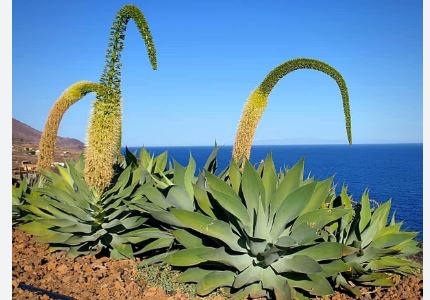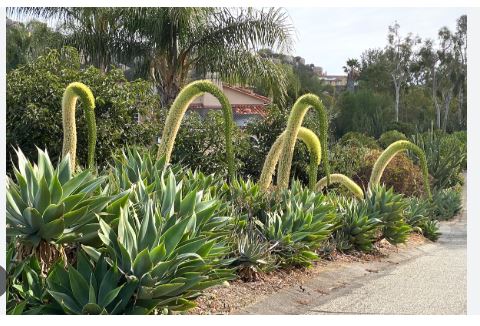
Agave attenuata, commonly known as the Foxtail Agave or Lion’s Tail Agave, belongs to the Asparagaceae family, subfamily Agavoideae. The genus Agave includes over 200 species of monocarpic succulents, characterized by their rosette-forming, fleshy leaves. Agave attenuata is distinct within the genus for its softer, less spiny foliage, making it a favored ornamental plant. Its taxonomic placement aligns it with other agaves native to the Americas, though its specific traits and lack of sharp spines set it apart from more rugged relatives like Agave americana. The species name “attenuata” refers to the tapering, pliable nature of its leaves.
The Foxtail Agave is recognized by its graceful, arching rosettes, which grow 4–5 feet (1.2–1.5 meters) wide and 3–4 feet (0.9–1.2 meters) tall. Its leaves are smooth, pale green to gray-green, and pliable, measuring 2–3 feet (60–90 cm) long and 4–6 inches (10–15 cm) wide, with no spines or marginal teeth, a rarity among agaves. The rosette’s soft texture and curved leaf tips give it a lush, almost tropical appearance. When mature (after 10–15 years), it produces a dramatic, curving flower spike, 8–14 feet (2.4–4.3 meters) tall, resembling a fox’s tail, with dense clusters of yellowish-green flowers. After flowering, the main rosette dies, but offsets (“pups”) ensure continued growth. Its sculptural form makes it a standout in gardens.
Agave attenuata is native to central Mexico, specifically the states of Jalisco, Michoacán, and México, where it grows on rocky slopes and cliffs in semi-arid, subtropical highlands at elevations of 4,000–8,000 feet (1,200–2,400 meters). In its native range, it thrives in well-drained, volcanic soils with moderate rainfall. Beyond Mexico, it has been widely cultivated as an ornamental plant in warm climates worldwide, including the Mediterranean, Australia, and the southwestern United States. While not naturalized extensively outside its native range, its adaptability to cultivation has made it a global favorite in frost-free or mild-winter regions.
Foxtail Agave is hardy in USDA zones 9b–11, tolerating temperatures as low as 25°F (-4°C) for short periods, though prolonged cold or frost can damage its succulent leaves. It thrives in warm climates with temperatures between 50°F and 90°F (10°C–32°C), making it ideal for coastal and desert regions. In zones below 9b, it is grown in containers or as a houseplant, brought indoors during winter to protect from freezing. Well-draining soil and minimal winter moisture are critical in marginal zones to prevent root rot during cooler months.
Agave attenuata is primarily used as an ornamental plant in landscaping and container gardening. Its soft, spineless leaves make it safe for high-traffic areas like patios, walkways, or poolside gardens, where it adds a tropical or desert aesthetic. It excels in xeriscapes, rock gardens, and Mediterranean-style landscapes, requiring minimal water once established. The plant is popular in pots, both indoors and outdoors, due to its manageable size and striking form. In warm climates, it’s used as a low-maintenance groundcover or accent plant in mass plantings. While it lacks the commercial utility of tequila-producing agaves, its offsets are easily propagated for nursery trade, and its flower stalks attract pollinators like bees and hummingbirds, enhancing garden biodiversity.

Agave attenuata (Foxtail Agave): Cultivation
Light Requirements
Provide full sun to partial shade, with 6–8 hours of sunlight daily for optimal growth. In hotter climates, morning sun with afternoon shade prevents leaf burn, especially for young plants. Indoors, place near a south- or west-facing window to ensure bright, indirect light, as insufficient light causes leggy growth.
Soil Preferences
Use well-draining soil, such as a cactus or succulent mix, with a pH of 6.0–7.5. A blend of 50% potting soil, 25% sand, and 25% perlite or pumice ensures proper drainage. In garden beds, amend heavy soils with gravel or organic matter to prevent water retention, which can lead to root rot.
Watering Needs
Water sparingly, allowing soil to dry completely between waterings. During spring and summer, water every 10–14 days, providing about 1 inch (2.5 cm) of water. In fall and winter, reduce to once every 3–4 weeks, as the plant enters dormancy. Overwatering is a primary cause of failure, so err on the side of underwatering.
Temperature Range
Grow in warm climates, ideally between 50°F and 90°F (10°C–32°C). Agave attenuata is hardy in USDA zones 9b–11, tolerating brief dips to 25°F (-4°C). Protect from frost by covering with frost cloth or moving potted plants indoors during cold snaps, as freezing damages leaves.
Humidity Levels
The plant thrives in low to moderate humidity (30–50%), typical of arid or coastal environments. High humidity can promote fungal issues, so ensure good air circulation, especially for indoor plants. Avoid misting, as the succulent leaves store sufficient water and excess moisture invites rot.
Container Selection
Choose pots with drainage holes to prevent water buildup. Terracotta or ceramic pots work well, allowing soil to dry efficiently. Select a container 1.5 times the rosette’s diameter to accommodate growth, but avoid oversized pots, which retain too much moisture for this drought-tolerant species.
Fertilization
Feed lightly with a diluted (1/4 strength) liquid succulent fertilizer (e.g., 5-10-10 NPK) once every 6–8 weeks during spring and summer. Avoid fertilizing in fall and winter, when growth slows. Over-fertilization leads to soft, weak leaves, so minimal feeding is best for maintaining compact form.
Propagation
Propagate via offsets (“pups”) that form around the base of mature plants. Gently separate pups with a clean, sharp knife, ensuring some roots remain, and let them callus for 1–2 days. Plant in well-draining soil and water lightly until established (2–4 weeks). Seed propagation is rare due to slow germination and inconsistent results.
Pruning
Minimal pruning is needed. Remove dead or damaged leaves at the base with sterile shears to maintain appearance and prevent pests. After flowering (which occurs after 10–15 years), the main rosette dies—cut the spent flower stalk and rely on offsets for continued growth.
Pest Control
Watch for pests like agave snout weevils, mealybugs, or scale insects. Inspect leaf bases regularly, as weevils lay eggs there, causing rot. Treat infestations with insecticidal soap or neem oil, applied in early morning. Healthy plants resist pests better, so avoid overwatering or poor drainage.
Repotting
Repot every 2–3 years or when the plant outgrows its container, typically in spring. Gently remove the agave, shake off old soil, and replant in fresh succulent mix. Ensure the new pot allows for drainage and provides enough space for the rosette’s spread without being overly large.
Flowering Care
Mature plants may produce a curving, 8–14-foot (2.4–4.3-meter) flower spike with yellowish-green blooms, attracting pollinators. Flowering signals the main rosette’s death, so focus on nurturing offsets for future growth. Support tall stalks with stakes if needed, and remove them post-bloom to tidy the plant.
Common Issues
Address overwatering (yellowing, mushy leaves) by reducing frequency and improving drainage. Underwatering (shriveled, curling leaves) requires slight increases in watering. Leaf burn from excessive sun can be mitigated with partial shade. Root rot, often from poor soil or pots, is prevented by prioritizing drainage and cautious watering.